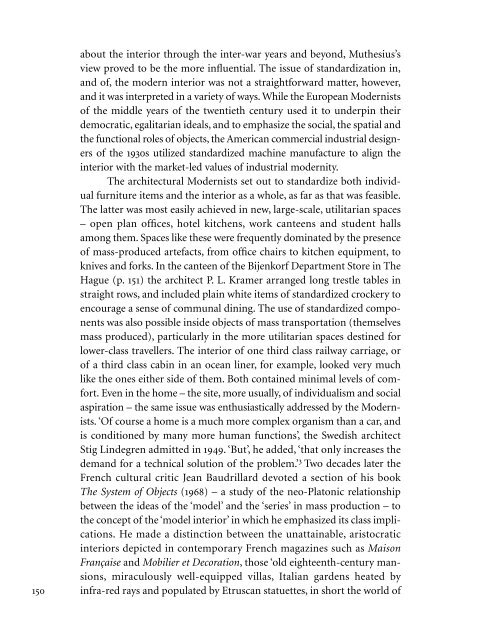You also want an ePaper? Increase the reach of your titles
YUMPU automatically turns print PDFs into web optimized ePapers that Google loves.
150<br />
about the interior through the inter-war years and beyond, Muthesius’s<br />
view proved to be the more influential. <strong>The</strong> issue of standardization in,<br />
and of, the modern interior was not a straightforward matter, however,<br />
and it was interpreted in a variety of ways. While the European <strong>Modern</strong>ists<br />
of the middle years of the twentieth century used it to underpin their<br />
democratic, egalitarian ideals, and to emphasize the social, the spatial and<br />
the functional roles of objects, the American commercial industrial designers<br />
of the 1930s utilized standardized machine manufacture to align the<br />
interior with the market-led values of industrial modernity.<br />
<strong>The</strong> architectural <strong>Modern</strong>ists set out to standardize both individual<br />
furniture items and the interior as a whole, as far as that was feasible.<br />
<strong>The</strong> latter was most easily achieved in new, large-scale, utilitarian spaces<br />
– open plan offices, hotel kitchens, work canteens and student halls<br />
among them. Spaces like these were frequently dominated by the presence<br />
of mass-produced artefacts, from office chairs to kitchen equipment, to<br />
knives and forks. In the canteen of the Bijenkorf Department Store in <strong>The</strong><br />
Hague (p. 151) the architect P. L. Kramer arranged long trestle tables in<br />
straight rows, and included plain white items of standardized crockery to<br />
encourage a sense of communal dining. <strong>The</strong> use of standardized components<br />
was also possible inside objects of mass transportation (themselves<br />
mass produced), particularly in the more utilitarian spaces destined for<br />
lower-class travellers. <strong>The</strong> interior of one third class railway carriage, or<br />
of a third class cabin in an ocean liner, for example, looked very much<br />
like the ones either side of them. Both contained minimal levels of comfort.<br />
Even in the home – the site, more usually, of individualism and social<br />
aspiration – the same issue was enthusiastically addressed by the <strong>Modern</strong> -<br />
ists. ‘Of course a home is a much more complex organism than a car, and<br />
is conditioned by many more human functions’, the Swedish architect<br />
Stig Lindegren admitted in 1949. ‘But’, he added, ‘that only increases the<br />
demand for a technical solution of the problem.’ 3 Two decades later the<br />
French cultural critic Jean Baudrillard devoted a section of his book<br />
<strong>The</strong> System of Objects (1968) – a study of the neo-Platonic relationship<br />
between the ideas of the ‘model’ and the ‘series’ in mass production – to<br />
the concept of the ‘model interior’ in which he emphasized its class implications.<br />
He made a distinction between the unattainable, aristocratic<br />
interiors depicted in contemporary French magazines such as Maison<br />
Française and Mobilier et Decoration, those ‘old eighteenth-century mansions,<br />
miraculously well-equipped villas, Italian gardens heated by<br />
infra-red rays and populated by Etruscan statuettes, in short the world of



